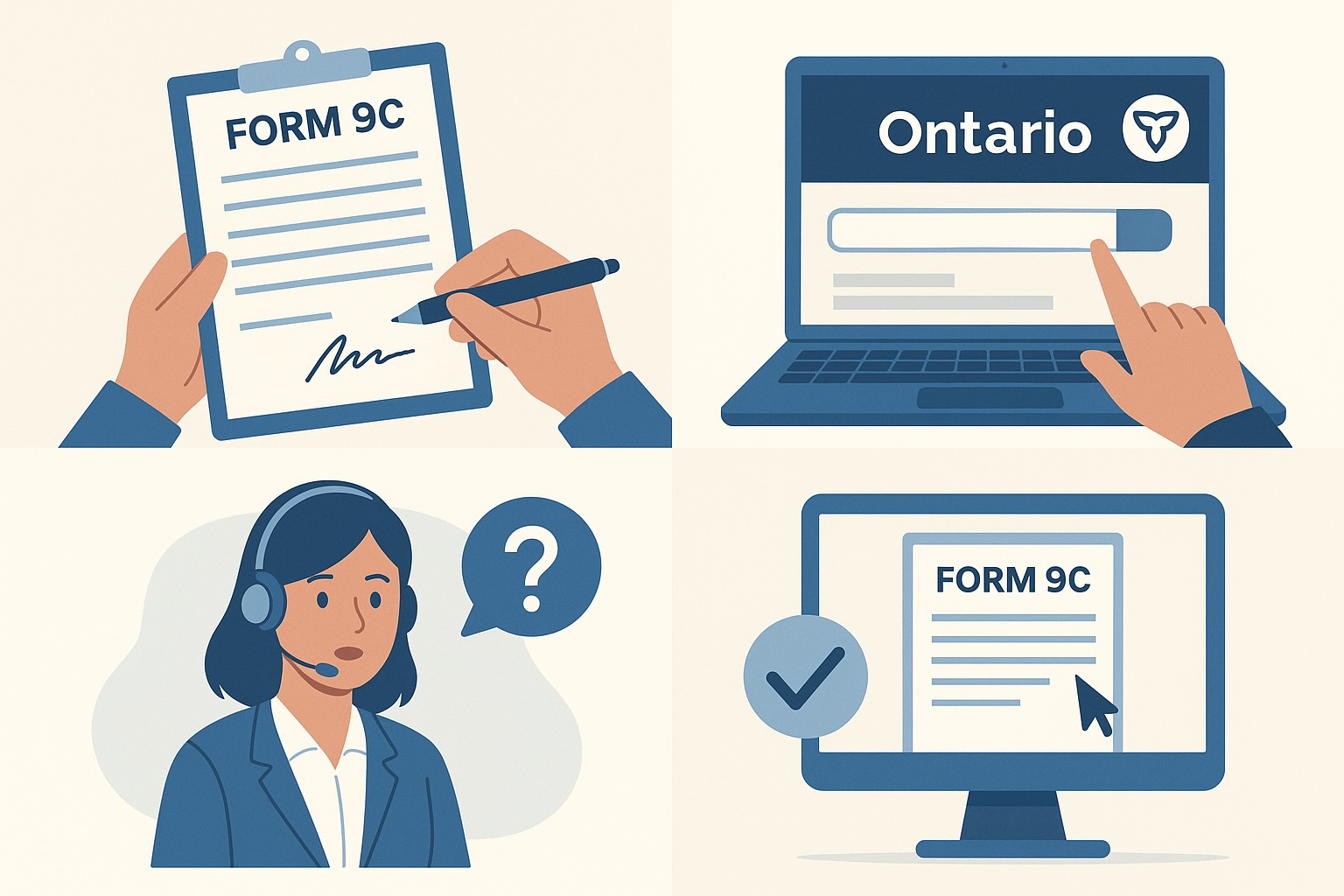How to File Form 9C in Ontario
Need protection from harassment or threats by someone outside your family? Learn how to complete and submit Form 9C (Non-Family Court Order) in Ontario and take the first legal step toward your safety.

# 📝 How to File Form 9C in Ontario
If you're experiencing threats, stalking, or harassment from someone who is **not a family member**, Ontario law gives you a tool to legally protect yourself—**Form 9C**. This form allows you to apply for a **Non-Family Court Restraining Order** through the Ontario Court of Justice.
In this guide, we’ll walk you through what Form 9C is, who should use it, and how to file it step-by-step.
***
### 📄 What is Form 9C?
**Form 9C: Application for Non-Family Court Order** is used when you're seeking a restraining order against someone who is:
* Not a spouse or partner
* Not a parent or child
* Not related by blood or marriage
Common examples include former roommates, neighbors, acquaintances, or strangers.
***
### 🔍 Step-by-Step Guide to Filing Form 9C
#### 1. Download the Form
Get the official PDF from the [Ontario Court Forms website](https://www.ontariocourtforms.on.ca/).
#### 2. Fill Out the Form
You'll need to include:
* Your personal details (name, address for service)
* The respondent’s details (if known)
* A description of the harassment or threatening behavior
* The type of order you are requesting (e.g., no contact, distance restrictions)
> 🔒 Tip: Include specific examples, dates, and any supporting documentation (texts, emails, incident reports).
#### 3. File the Form at the Ontario Court of Justice
Visit your local courthouse and file the completed Form 9C at the clerk’s office.
* Filing may be done in person or online (varies by region).
* You may need to pay a filing fee, but fee waivers are available for low-income applicants.
#### 4. Serve the Respondent
After filing, a copy of the form must be **served** to the person you're seeking protection from. You **cannot serve it yourself**—use a process server or someone 18+ who is not involved in the case.
Make sure you file an **Affidavit of Service** to prove that the respondent received it.
#### 5. Attend the Hearing
On your court date:
* Bring all evidence and documents.
* Explain clearly why the order is necessary.
* The judge may grant a temporary or final restraining order depending on the situation.
***
### ✅ What Happens After Filing?
If the restraining order is granted:
* It will state what the respondent can and cannot do.
* Police can enforce the order if it’s violated.
* Keep a copy of the order with you at all times.
***
### ⚖️ Need Help?
If you’re unsure how to file or need assistance, contact:
* **Legal Aid Ontario**: 1-800-668-8258
* **Victim Support Line**: 1-888-579-2888
* Local legal clinics or women's shelters
***
Here are the updated versions of each blog post with **direct links to relevant Ontario court forms** added in the appropriate sections:
**🧾 Legal Form**:➡️ [Form 9C – Application for Non-Family Court Order (PDF)](https://www.ontariocourtforms.on.ca/static/media/uploads/courtforms/civil/09c/flr-9c-e.pdf)Used to apply for a restraining order against someone who is not a spouse or relative.
**📄 Also Useful**:
* [Form 6B – Affidavit of Service (PDF)](https://ontariocourtforms.on.ca/static/media/uploads/courtforms/family/06b/flr-6b-e.pdf) Required after serving the respondent.
***
### Frequently Asked Questions (FAQs)
#### 1. What is the main purpose of Form 9C?
Form 9C is a legal document used to start a court application for a restraining order against a non-family member in the Ontario Court of Justice. Its purpose is to seek legal protection from harassment, stalking, or threats.
#### 2. Can I ask for an urgent restraining order with Form 9C?
Yes. If you are in immediate danger, you can ask the court for an urgent, temporary order without giving notice to the other person. You must provide strong evidence to convince the judge that the situation is a true emergency.
#### 3. What kind of evidence should I include with my application?
The more evidence, the better. Include screenshots of text messages and social media posts, copies of emails, photos, a detailed timeline of events, and any police report numbers related to the incidents.
#### 4. What happens if I don't serve the respondent correctly?
If you do not serve the respondent properly and file the Affidavit of Service (Form 6B), the court cannot proceed with your hearing. Proper service is a fundamental rule of the court system to ensure the other party has a fair chance to respond.
#### 5. What if I don't know the respondent's address to serve them?
If you do not know the respondent's address, you can ask the judge for an order for "substitutional service," which allows you to serve them in a different way, such as by email or through a family member. You must explain to the judge why you cannot serve them in person.
#### 6. Where can I get help filling out Form 9C?
The legal process can be confusing. You can get help from a lawyer, a community legal clinic, or a victim services organization. They can help ensure your forms are filled out correctly and that you have all the necessary evidence to support your case.
